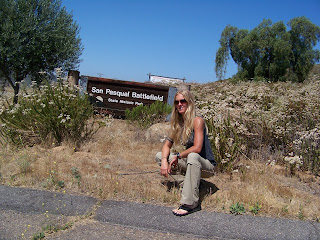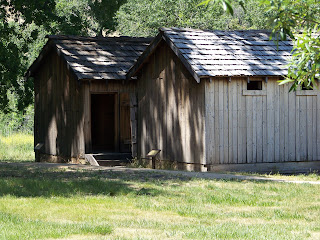I arrived at San Pasqual Battlefield State Historic Park and discovered that it is only open on weekends; it was Wednesday.
According to the State Parks website, San Pasqual Battlefield SHP serves not as a memorial to war but as a reminder of the "human ideals, actions, and passions" that lead to war.
The park is located at the site of one of the most devastating battles of the Mexican-American War. The battle took place on December 6, 1846 and had no clear outcome.
 The park holds living history events in which the battle is re-enacted and the public can enjoy period crafts and music.
The park holds living history events in which the battle is re-enacted and the public can enjoy period crafts and music.
To get a better idea of what these events entail checkout Battlelines, a bimonthly newsletter put out by the San Pasqual Battlefield Volunteer Association.
To get to my next destination, Fort Tejon SHP, I drove past the rolling hills that are home to many Indian reservations, through the beautiful and delightfully overcast Oceanside, San Diego, and crawled through the blistering heat and smog of LA.
 Fort Tejon State Historic Park is located directly off of I-5 along the Grapevine. The Fort is a grim and necessary reminder of the European conquest of California and the United States; it was created to control local Indian populations.
Fort Tejon State Historic Park is located directly off of I-5 along the Grapevine. The Fort is a grim and necessary reminder of the European conquest of California and the United States; it was created to control local Indian populations.
As I wandered about the buildings and other displays in the 102 degree heat, I noticed the heaviness of the uniforms worn by the soldiers; they appeared to be made mostly of wool with long sleeves, long pants, and tall boots. I also took note of the sour and disgruntled look of most of the Europeans depicted in the images, and wondered if the Europeans had dressed more  appropriately for the climate would they have been less cranky?
appropriately for the climate would they have been less cranky?
I left Fort Tejon after dousing myself in a sprinkler and headed off to Tule Elk State Reserve in Buttonwillow.
Once again, I found myself withering along 1-5 in the tenacious summer heat with a plethora of welts from mosquito bites begging to be scratched beneath sweat softened skin. One of the most intriguing phenomena about travel and adventure is the apparent amnesia we have about the inevitable suffering we experience during our adventures; the delight we take in relaying said suffering to others post-trip, and finally, craving the suffering and heading out again.
The first time I visited Tule Elk State Reserve it was as a scientific aide for the Department of Fish and Game. At that time the reserve was very dry because the agency in charge of the water had diverted it elsewhere. With the temperature at its high for the day (103 degrees), I pulled into the shaded parking lot of the reserve which was much cooler than I expected. The area now looked like Tule Elk habitat with marsh and reeds and maintained a delightfully cool temperature because of the presence of the water which had been returned to the reserve since my last visit.
Tule Elk were nearly extinct when Henry Miller,  a rancher, began the effort to preserve the species in 1874. The elk are managed by the California Department of Fish and Game, but housed all over the state. They can be found at the Tule Elk State Reserve and at Point Reyes National Seashore among other places. I wonder what will become of the herd here? Does the closure of this park effect Fish and Game, and if so , how?
a rancher, began the effort to preserve the species in 1874. The elk are managed by the California Department of Fish and Game, but housed all over the state. They can be found at the Tule Elk State Reserve and at Point Reyes National Seashore among other places. I wonder what will become of the herd here? Does the closure of this park effect Fish and Game, and if so , how?
Without my binoculars I was forced to use the zoom of my camera (perhaps with better results) to find the elk. It took a minute, but eventually I made out some funny looking sticks on the horizon…













